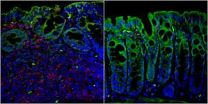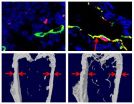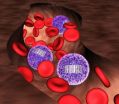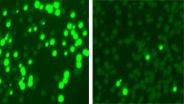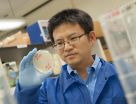(Press-News.org) An international collaboration of scientists has identified a fifth of the genetic factors that cause height to vary between individuals.
A study which examined data on DNA from more than 250,000 people, published on October 6 in Nature Genetics, roughly doubles the number of known genome regions involved in height to more than 400. It also revealed that more than half of the factors involved in determining height are explained by simple common genetic variation - the sort of genetic variation that exists in more than 1 in 10 people.
The collaboration, co led by the University of Exeter Medical School and part-funded by the Wellcome Trust, involved more than 450 experts from well over 300 institutions in Australia, the USA and several European countries. Together, they form the aptly named GIANT consortium. The study is the largest of its kind to date. They checked more than 2 million common genetic factors – those shared by at least five per cent of participants. From this they found 697 genetic variants in 424 regions of the genome that are related to height. The findings represent a massive stride forward in an area of research in which virtually nothing was known as recently as 2007.
Professor Tim Frayling, of the University of Exeter Medical School, oversaw the study. He said: "It's common knowledge that people born to tall parents are more likely to be tall themselves. Most of this is down to the variations in our DNA sequence that we inherit from our parents - the different versions of all our genes. In 2007 we published the first paper that identified the first common height gene, and since then the research has come on leaps and bounds. We have now identified nearly 700 genetic variants that are involved in determining height. This goes a long way towards fulfilling a scientific curiosity that could have real impact in the treatment of diseases that can be influenced by height, such as osteoporosis, cancer or heart disease. It also a step forward towards a test that may reassure parents worried that their child is not growing as well as they'd hoped - most of these children have probably simply inherited a big batch of "short genes."
Height is determined by a very large, but finite, number of contributing factors. Genetic causes are located throughout the genome, and environmental factors such as diet also play a role. The GIANT consortium is working towards identifying the thousands of hidden factors which have varying effects in height, ranging from minute to gigantic. The results arise from analysis of DNA data on 253,288 individuals of European ancestry. The research team says increasing sample sizes of this magnitude make it far easier to find commonalities that determine traits such as size.
Lead author Dr Andrew Wood, of the University of Exeter Medical School, said: "Our findings have helped to identify a large proportion of the genetic architecture that contributes to determining our height. We know that as a population we have become taller over the last few generations, because of factors including improved nutrition. But more than 80 per cent of the factors in height variation are known to be down to genetics, with the rest caused by environmental factors. Thanks to advances in technology, we now have access to far greater quantities of DNA data. These data sets are proving to be a genetic treasure trove which has enabled us to shed light on height, and we expect to continue to make significant advances, both in this field and in other human traits. Our results suggest that massive human genetic studies, possibly into the millions, will continue to uncover all the subtle effects of our genetic variation that influence our health, behaviour, body shape and all aspects of what makes us who we are."
Dr Joel Hirschhorn, of Boston Children's Hospital and the Broad Institute of MIT and Harvard, is leader of the GIANT Consortium and co-senior investigator on the study. Dr Hirschhorn said: "When you double the sample size and increase your statistical power, you can make new discoveries. Our results prioritise many genes and pathways as important in skeletal growth during childhood. Without a highly collaborative model, there's no way we could get this work done. We can now explain about 20 percent of the heritability of height, up from about 12 percent where we were before."
Professor Peter Visscher, of the University of Queensland, Australia, said: "The study narrows down the genomic regions that contain a substantial proportion of remaining variation—to be discovered with even larger sample sizes."
Professor Frayling said: "The genes and pathways involved in height should help facilitate future studies, and we have made them publicly available to this end. We believe that large genetic studies could yield similarly rich lists in a variety of other traits, and could generate new biological hypotheses and motivate future research into the basis of human biology and disease."
INFORMATION:
A tall story: Great strides in identifying genetic factors in height
An international collaboration of scientists has identified a fifth of the genetic factors that cause height to vary between individuals
2014-10-05
ELSE PRESS RELEASES FROM THIS DATE:
Scientists discover pain receptor on T-cells
2014-10-05
Researchers at University of California, San Diego School of Medicine have discovered that T-cells – a type of white blood cell that learns to recognize and attack microbial pathogens – are activated by a pain receptor.
The study, reported online Oct. 5 in Nature Immunology, shows that the receptor helps regulate intestinal inflammation in mice and that its activity can be manipulated, offering a potential new target for treating certain autoimmune disorders, such as Crohn's disease and possibly multiple sclerosis.
"We have a new way to regulate T-cell activation ...
'Unsung' cells double the benefits of a new osteoporosis drug
2014-10-05
Experiments in mice with a bone disorder similar to that in women after menopause show that a scientifically overlooked group of cells are likely crucial to the process of bone loss caused by the disorder, according to Johns Hopkins researchers. Their discovery, they say, not only raises the research profile of the cells, called preosteoclasts, but also explains the success and activity of an experimental osteoporosis drug with promising results in phase III clinical trials.
A summary of their work will be published on Oct. 5 in the journal Nature Medicine.
"We didn't ...
GIANT study reveals giant number of genes linked to height
2014-10-05
The largest genome-wide association study (GWAS) to date, involving more than 300 institutions and more than 250,000 subjects, roughly doubles the number of known gene regions influencing height to more than 400. The study, from the international Genetic Investigation of Anthropometric Traits (GIANT) Consortium, provides a better glimpse at the biology of height and offers a model for investigating traits and diseases caused by many common gene changes acting together. Findings were published online October 5 by Nature Genetics.
"Height is almost completely determined ...
Scientists develop barcoding tool for stem cells
2014-10-05
A 7-year-project to develop a barcoding and tracking system for tissue stem cells has revealed previously unrecognized features of normal blood production: New data from Harvard Stem Cell Institute scientists at Boston Children's Hospital suggests, surprisingly, that the billions of blood cells that we produce each day are made not by blood stem cells, but rather their less pluripotent descendants, called progenitor cells. The researchers hypothesize that blood comes from stable populations of different long-lived progenitor cells that are responsible for giving rise to ...
Discovery of a novel heart and gut disease
2014-10-05
This news release is available in French and German. Physicians and researchers at CHU Sainte-Justine, Université de Montréal, CHU de Québec, Université Laval, and Hubrecht Institute have discovered a rare disease affecting both heart rate and intestinal movements. The disease, which has been named "Chronic Atrial Intestinal Dysrhythmia syndrome" (CAID), is a serious condition caused by a rare genetic mutation. This finding demonstrates that heart and guts rhythmic contractions are closely linked by a single gene in the human body, as shown in a study published on October ...
Breakthrough allows researchers to watch molecules 'wiggle'
2014-10-05
A new crystallographic technique developed at the University of Leeds is set to transform scientists' ability to observe how molecules work.
A research paper, published in the journal Nature Methods on October 5, describes a new way of doing time-resolved crystallography, a method that researchers use to observe changes within the structure of molecules.
Although fast time-resolved crystallography (Laue crystallography) has previously been possible, it has required advanced instrumentation that is only available at three sites worldwide. Only a handful of proteins ...
Air pollution increases river-flows
2014-10-05
A study published in Nature Geoscience shows that air pollution has had a significant impact on the amount of water flowing through many rivers in the northern hemisphere.
The paper shows how such pollution, known as aerosols, can have an impact on the natural environment and highlights the importance of considering these factors in assessments of future climate change.
The research resulted from a collaboration between scientists at the Met Office, Centre for Ecology and Hydrology, University of Reading, Laboratoire de Météorologie Dynamique in France, and the University ...
'Programmable' antibiotic harnesses an enzyme to attack drug-resistant microbes
2014-10-05
The multitude of microbes scientists have found populating the human body have good, bad and mostly mysterious implications for our health. But when something goes wrong, we defend ourselves with the undiscriminating brute force of traditional antibiotics, which wipe out everything at once, regardless of the consequences.
Researchers at Rockefeller University and their collaborators are working on a smarter antibiotic. And in research to be published October 5 in Nature Biotechnology, the team describes a 'programmable' antibiotic technique that selectively targets the ...
Attacking type 2 diabetes from a new direction with encouraging results
2014-10-05
Type 2 diabetes affects an estimated 28 million Americans according to the American Diabetes Association, but medications now available only treat symptoms, not the root cause of the disease. New research from Rutgers shows promising evidence that a modified form of a different drug, niclosamide – now used to eliminate intestinal parasites – may hold the key to battling the disease at its source.
The study, led by Victor Shengkan Jin, an associate professor of pharmacology at Rutgers Robert Wood Johnson Medical School, has been published online by the journal Nature ...
A discovery could prevent the development of brain tumors in children
2014-10-03
Montréal, October 2, 2014 – Scientists at the IRCM discovered a mechanism that promotes the progression of medulloblastoma, the most common brain tumour found in children. The team, led by Frédéric Charron, PhD, found that a protein known as Sonic Hedgehog induces DNA damage, which causes the cancer to develop. This important breakthrough will be published in the October 13 issue of the prestigious scientific journal Developmental Cell. The editors also selected the article to be featured on the journal's cover.
Sonic Hedgehog belongs to a family of proteins that gives ...
LAST 30 PRESS RELEASES:
Interaction of climate change and human activity and its impact on plant diversity in Qinghai-Tibet plateau
From addressing uncertainty to national strategy: an interpretation of Professor Lim Siong Guan’s views
Clinical trials on AI language model use in digestive healthcare
Scientists improve robotic visual–inertial trajectory localization accuracy using cross-modal interaction and selection techniques
Correlation between cancer cachexia and immune-related adverse events in HCC
Human adipose tissue: a new source for functional organoids
Metro lines double as freight highways during off-peak hours, Beijing study shows
Biomedical functions and applications of nanomaterials in tumor diagnosis and treatment: perspectives from ophthalmic oncology
3D imaging unveils how passivation improves perovskite solar cell performance
Enriching framework Al sites in 8-membered rings of Cu-SSZ-39 zeolite to enhance low-temperature ammonia selective catalytic reduction performance
AI-powered RNA drug development: a new frontier in therapeutics
Decoupling the HOR enhancement on PtRu: Dynamically matching interfacial water to reaction coordinates
Sulfur isn’t poisonous when it synergistically acts with phosphine in olefins hydroformylation
URI researchers uncover molecular mechanisms behind speciation in corals
Chitin based carbon aerogel offers a cleaner way to store thermal energy
Tracing hidden sources of nitrate pollution in rapidly changing rural urban landscapes
Viruses on plastic pollution may quietly accelerate the spread of antibiotic resistance
Three UH Rainbow Babies & Children’s faculty elected to prestigious American Pediatric Society
Tunnel resilience models unveiled to aid post-earthquake recovery
Satellite communication systems: the future of 5G/6G connectivity
Space computing power networks: a new frontier for satellite technologies
Experiments advance potential of protein that makes hydrogen sulfide as a therapeutic target for Alzheimer’s disease
Examining private equity’s role in fertility care
Current Molecular Pharmacology achieves a landmark: real-time CiteScore advances to 7.2
Skeletal muscle epigenetic clocks developed using postmortem tissue from an Asian population
Estimating unemployment rates with social media data
Climate policies can backfire by eroding “green” values, study finds
Too much screen time too soon? A*STAR study links infant screen exposure to brain changes and teen anxiety
Global psychiatry mourns Professor Dan Stein, visionary who transformed mental health science across Africa and beyond
KIST develops eco-friendly palladium recovery technology to safeguard resource security
[Press-News.org] A tall story: Great strides in identifying genetic factors in heightAn international collaboration of scientists has identified a fifth of the genetic factors that cause height to vary between individuals
